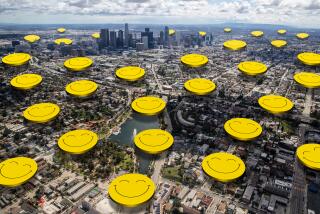A Stroll Through Charming Copenhagen
- Share via
COPENHAGEN — Begin a typical day in Denmark by watching a golden sun climb into the light blue of a northern sky. It chases an equally full silver moon arching down over a skyline of graceful church spires, parks, canals and antique buildings studded with statues and topped by red tiles and green copper roofs. The city is a walker’s paradise. No matter which way you go, along cobbled narrow alleyways or on broader birch-lined streets, something will appear to gladden your tourist heart. The favorite of visitors as well as residents is the Stroget, or “stroll,” granddaddy of all malls. Along its colorful route you’ll find a fresh fish shop next to an expensive fur salon, vegetable and fruit stalls that are three-dimensional paintings, tables piled high with bargains scattered along the middle of the stroll. (How about a handmade ski sweater for $60?) Despite the jostling crowds, people still smile at each other here, perhaps because of the festive music that lends a carnival air. You hear solo guitars, the close harmony of trios, 20-piece uniformed bands--musicians of every kind and talent. I even saw some happy players in bib coveralls, red neckerchiefs and straw hats stomping their feet in rhythm doing a bluegrass version of “Drink That Mash and Talk That Trash.” Pure Tennessee in Denmark. From the Stroget it’s an easy walk to Nyhavn Street and Canal, a pleasant coffee stop for people and boat watching. Statues of heroes and kings lead the way. My favorites are a portly fisherwoman in billowing skirts holding onto a fish almost as big as she is. Watching her a few yards away is a mean-looking bishop swinging a huge battle-ax. One suspects that his converts came easy. One side of Nyhavn is lined with 500-year-old houses that are narrow, high with steep-peaked roofs and painted in crayon colors. Several are a mild yellow, which seems to be Denmark’s national color. You’ll find it on barns, barracks, farms, beach houses--even in the wheat fields with rolled-up bales of hay in the same sunny hue.
The canal is gunwale to gunwale with barges and worn-out schooners with work scars on their hulls. New ships are tied to old ones and a graveyard of retired lighthouse ships rust through their retirement.
The Fyrski is an exception. Its black-and-red hull is freshly painted and its beveled glass beacon attracts hungry patrons to its second life as a restaurant where they serve more than 50 kinds of fish. At dusk, with the city background dimming away in mist, it’s easy to imagine its glory days of tossing about on stormy seas and guiding lost sailors safely home.
Farther along the canal opposite the storybook houses are half a dozen sidewalk cafes dotted with bright umbrellas and roomy chairs for weary walkers. Their names are what young boys’ dreams are made of: the Hong Kong, Cape Horn, On the Sunny Side and the Mary Rose.
Beyond that a sign enticed us to a dingy step-down tattoo parlor run by Jack and Bimbo. The small dusty glass window of their enterprise is covered with cobwebs and fading suggestions that make up in color what they lack in museum quality.
Variety of Keepsakes
Permanent keepsakes include flowers, snakes, panthers, daggers, hearts, flags and “Mother” in the language of your choice. As a piece de resistance, if your back can handle it, they’ll gladly embellish it with “The Last Supper” for $200.
Saying goodby to colorful Nyhavn Street you pass No. 17, the dormer house where Denmark’s gift to fairy tales, Hans Christian Andersen, spent the last years of his life. Sad that after giving so much joy to so many he ended up a lonely old man.
The man who turned “The Ugly Duckling” into a beautiful swan, the Steadfast Tin Solder into a hero and made the Little Mermaid as recognizable as Mt. Rushmore will never be forgotten. One can hardly walk 50 yards before coming across a house where he stayed, a statue of him surrounded by flowers or a tree that he sat under. He became one of the most popular personalities in Europe and a friend to children everywhere.
His own childhood was poignant. In the small farming village of Odense where he was born the son of a poor cobbler and a washerwoman, he shared a bed with eight others. They slept feet to feet like the spokes of a buggy wheel. His fairy tales were probably a world of escape.
Although the Little Mermaid has had her share of publicity, no one is quite ready for her. She is not in the middle of the sound as many imagine, but sits only a few feet from the shore where you can walk right up to her.
Hoping for a Soul
No bigger than a high school cheerleader, she sits wistfully on her rock, hoping, legend has it, for a soul so that she can leave the loneliness of the sea and join the world of people. Visitors become quiet in her presence as if they don’t want to interrupt her thoughts.
Keeping herself in one piece hasn’t been easy. She has been beheaded by vandals. Two tipsy pranksters once cut off her arms and spent three years in jail for that surgical malpractice. But the Mermaid has been lovingly restored and is as appealing as ever.
As popular an attraction as the Mermaid is Tivoli Gardens, one of the most extraordinary parks in the world. Woods, paths and hidden ponds make up this tiny country of 45 acres in the heart of the city where a child’s world comes true and an adult can become young again.
At night the stars compete with the small yellow light bulbs strung through the gardens like squadrons of fireflies guiding the way to the Punch and Judy shows, the fun houses and the antebellum restaurants with gingerbread verandas as neat as doll houses.
Walt Disney gave Tivoli lots of credit for his wonder worlds and it’s said that he used to sit on one of the wrought-iron benches and toss aside candy wrappers just to see how long it would be before they were picked up by an employee.
Grand Old Building
Within two blocks of Tivoli is the Palace Theater that shows 21 movies simultaneously, and just down the street is a grand old building where a circus has been going on every day for more than 70 years.
Not far from the palace grounds is the American Embassy with its high walls, looking solid, covered with streaks of rich red ivy. Nearby is the Soviet Embassy.
Last year when President Reagan and Secretary General Gorbachev had their first summit meeting in Geneva, some Danish women and children, dressed in white and carrying candles, walked back and forth between the two embassies hoping, perhaps, that they could throw a little light on wander everywhere. A library right out of a castle is a tasteful, relaxing place to wait and sip a cocktail.
As for candles, that’s all they have--in wall sconces, in leaded-glass lanterns, on tables--more than 3,000. If candles go with romance, you’ll fall in love instantly with whomever you’re with. One employee’s only job is to keep them lit.
Almost as important as Scandinavian food is immunizing yourself to the favorite drink that fans of Denmark know as aquavit. Made from potatoes, it’s called the Water of Life and no meal is complete without a lot of toasting. This ritual is called skoaling and seems to occur every 30 seconds without warning.
It’s rude not to participate, and part of the ceremony is to raise your glass of innocent looking golden ambrosia and toss it off. The Water of Life did in at least two in our party before dinner was over.
For more information contact the Scandinavian Tourist Board, 655 3rd Ave., New York 10017, phone (212) 949-2333.
More to Read
Sign up for The Wild
We’ll help you find the best places to hike, bike and run, as well as the perfect silent spots for meditation and yoga.
You may occasionally receive promotional content from the Los Angeles Times.






